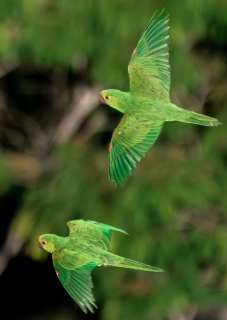White-eyed Conure |
|
|
Also known as: White-eyed Parakeet, Green Conure
Photos
View in GalleryDid You Know?
The White-eyed Conure usually nests in a high tree cavity but may also nest in limestone caverns, particularly in Brazil.Programs & Projects
WPT has worked with numerous partners to help save this species. Learn moreAcademic Research
Related publications: Psittacara leucophthalmusSpecies Profile
Genus: Psittacara | Species: leucophthalmus
Size:
32cm (12.5 in)
Weight:
140-170g (5-6 oz)
Subspecies including nominate:
four: P.l. leucophthalmus, P.l. callogenys, P.l. propinquus, P.l. nicefori
Colour Adult:
P.l. leucophthalmus: Both adults in general green, with variable scattering of red feathers on head and neck; red carpal edge and edge of forewing; red outer lesser underwing coverts, green inner coverts; yellow outer greater underwing coverts, olive inner coverts. Bill horn in colour. Eye ring bare and white. Eye orange.
P.l. callogenys: Both adults as in leucophthalmus, but with larger bill. Larger in size. Western birds have darker green body colour.
P.l. propinquus: Both adults as in leucophthalmus, but larger in size.
P.l. nicefori: Both adults as in callogenys, but in general body colour paler and more yellow; red stripe across forehead.
Colour Juvenile:
P.l. leucophthalmus: As in adults but with yellow/green carpal edge and edge of forewing, suffused with red; olive/green outer greater underwing coverts; red feathers on head and neck minimal or absent. Shorter tail. Eye brown.
Call:
Calls made in flight are repetitious and sharp, almost metallic, notes. Also emits scolding and grating sounds, and more melodious notes.
Listen NowVideo Links:
Video 1 | Video 2 | Video 3More Information:
Content Sources:
CITES
BirdLife International
Cornell Lab of Ornithology/Birds of the World
Parrots: A Guide to Parrots of the World, Juniper and Parr, 1998
xeno-canto White-eyed Parakeet, Guilherme, Edison, XC339739
Parrots of the World, Forshaw and Cooper, 1977. 2010 edition
Parrots of the World, Forshaw, 2006.
Parrots in Aviculture, Low, 1992.
Psittacine Aviculture, Schubot, Clubb and Clubb, 1992.
Photos
View in GalleryDid You Know?
The White-eyed Conure usually nests in a high tree cavity but may also nest in limestone caverns, particularly in Brazil.Programs & Projects
WPT has worked with numerous partners to help save this species. Learn moreAcademic Research
Related publications: Psittacara leucophthalmusSpecies Care
Captive Status:
Not common.
Longevity:
25-30 yrs
Housing:
Aviary or suspended enclosure, minimum length 3m (9.8 ft).
Diet:
Fruits such as: apple, pear, banana, orange, cactus fruits, pomegranates, forming about 30 percent of the diet; vegetables such as: carrots, celery, green beans and peas in the pod; fresh corn; green leaves such as: Swiss chard, lettuce, sowthistle, dandelion, chickweed; spray millet; small seed mix such as: millet, canary, and smaller amounts of oats, buckwheat, safflower and a little hemp; soaked and sprouted sunflower seed; cooked beans and pulses, boiled maize, and complete pellet.
Enrichment:
Provide water bowls for bathing; swings, ladders, ropes, puzzle/foraging toys, vegetable tanned leather chew toys, bird-safe wooden toys; fir, pine and willow branches and perches, heat sterilized pine cones.
Nest Box Size:
Vertical box 12" x 12" x 18" (30.5cm x 30.5cm x 46cm).
Clutch Size:
4
Incubation Time:
Probably 24 days.
Fledging Age:
9 weeks
Hatch Weight:
Not recorded.
Peak Weight:
Not recorded.
Weaning Weight:
Not recorded.
Photos
View in GalleryDid You Know?
The White-eyed Conure usually nests in a high tree cavity but may also nest in limestone caverns, particularly in Brazil.Programs & Projects
WPT has worked with numerous partners to help save this species. Learn moreAcademic Research
Related publications: Psittacara leucophthalmusSpecies Wild Status
World Population:
Unknown, decreasing.
IUCN Red List Status:
Least Concern
CITES Listing:
Appendix II
Threat Summary:
Not globally threatened. Common over much of enormous range. High volume of international trade, particularly in Argentina, where the species may be under some threat. Heavily traded in Venezuela but apparently not to detrimental effect.
Range:
P.l. leucophthalmus: Guianas, NE Venezuela, from SE Sucre, Monagas, and N Anzoategui to NE Bolivar, and E Colombia, south from Meta, south through Brazil, except upper Amazon River basin, dry northeast and southeast, to E Bolivia, Paraguay and N Argentina, south to Catamarca and N Sante Fe and Entre Rios and into N Uruguay.
P.l. callogenys: Upper Amazonia, near foothills of Andes, in SE Colombia, E Ecuador, and NE Peru to NW Brazil.
P.l. propinquus: SE Brazil in Santa Catarina and Rio Grande do Sul, to NE Argentina, in Misiones and Corrientes.
P.l. nicefori: One specimen collected at Guaicaramo, on Rio Guavio, Meta, Colombia. Possibly a hybrid.
Habitat:
Found up to 2500m (8200 ft) in a range of mainly lowland forest and woodland types. In Amazonia is found in tropical rainforest mostly near to rivers, scattered woodland and cultivated land in the pantanals, mangroves, savanna and palms; chaco woodland in the south, gallery and floodplain forests in Bolivia.
Wild Diet:
Diet includes fruits of Goupia glabra, Tetragastris altissima, Allanotoma lineata, Norantea guianensis, Fagara and palms, blossoms of Erythrina and Ficus frondosa, grass seeds and insects.
Ecology and Behaviour:
Very gregarious, commonly forming flocks of several hundred birds which range widely along riverways between feeding areas and roosts. Roosts communally in trees, canefields and caves. Travels with Blue-crowned Conures, Blue-headed Parrots, Chestnut-fronted Macaws and Crimson-bellied Conures.
Clutch and Egg Size:
4 eggs, 31.0 x 25.0mm (1.2 x 1 in).
Breeding Season:
November-December, Argentina; July-August, E Peru; January-April, Mato Grosso. Nest is in tree hollow.
Photos
View in GalleryDid You Know?
The White-eyed Conure usually nests in a high tree cavity but may also nest in limestone caverns, particularly in Brazil.Programs & Projects
WPT has worked with numerous partners to help save this species. Learn moreAcademic Research
Related publications: Psittacara leucophthalmusMembers Only Resources
Please log-in now to find more research, resources and tools.
Not a Member?
Find more great information:
Gain exclusive access to 600+ pages of additional research, seminars and podcasts, specialists to ask your toughest questions, and dozens of other fun resources - when you become a WPT member.
Join Today >>

































